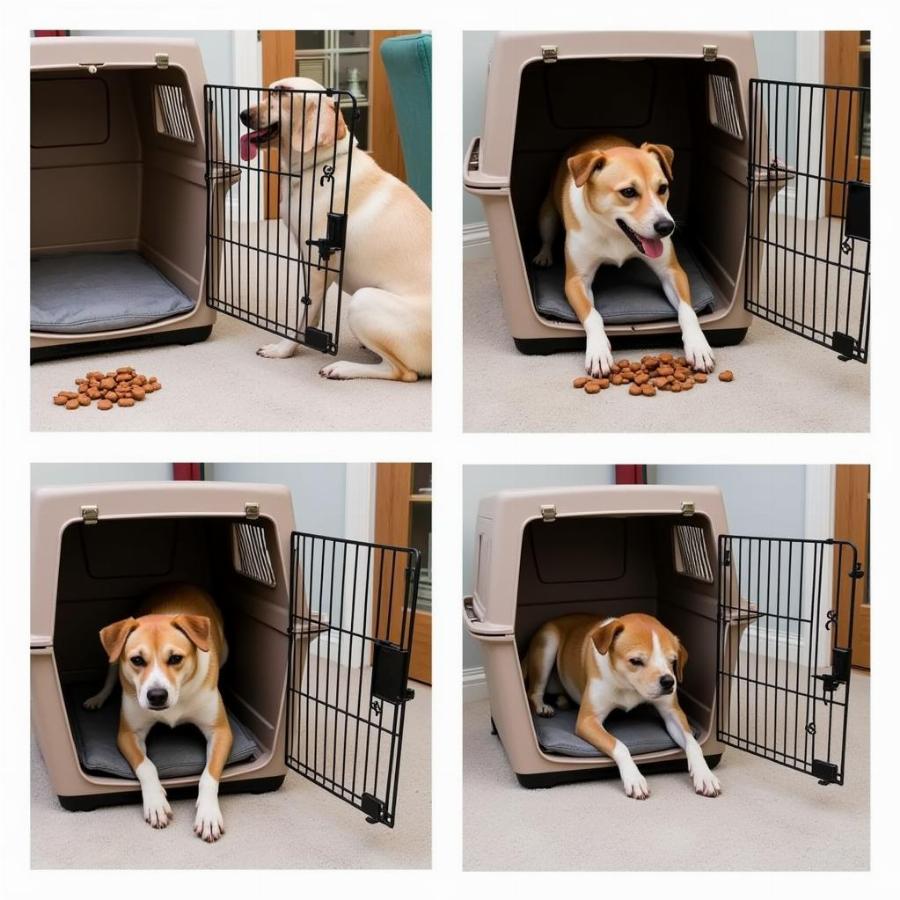Crate training can be a rewarding experience for both you and your furry friend, but the initial stages can be challenging, especially if your dog cries incessantly. Understanding why your dog is crying and implementing effective strategies can make the transition smoother and establish a positive association with the crate. This guide will provide practical tips and advice on how to stop dog crying in crate, fostering a comfortable and secure environment for your beloved pet.
Understanding Why Your Dog Cries in the Crate
Before tackling the issue of how to stop dog crying in crate, it’s essential to understand the underlying reasons for their distress. Puppies, in particular, often cry due to separation anxiety, as they are used to being close to their mother and littermates. Older dogs might cry due to fear, boredom, or previous negative experiences with confinement. Identifying the root cause can help you tailor your approach to crate training more effectively. Is it separation anxiety, a lack of comfort, or simply a need for a potty break? Once you understand the “why,” the “how” becomes much clearer.
Creating a Positive Crate Environment
Turning the crate into a positive and inviting space is crucial for how to stop dog crying in crate. Start by placing the crate in a familiar area of your home where your dog feels comfortable and safe. A cozy bed, a favorite toy, and a blanket with your scent can help create a sense of security and familiarity. Avoid using the crate as a form of punishment, as this can create negative associations and exacerbate the crying. Make it a haven, not a prison.
Gradual Introduction to the Crate
Introducing your dog to the crate gradually is key for a positive experience. Start by leaving the crate door open and tossing treats and toys inside, encouraging your dog to explore on their own terms. Feed your dog meals near or inside the crate to build positive associations. Gradually increase the time your dog spends in the crate, starting with short periods and gradually extending the duration as they become more comfortable. Patience is essential in this process; don’t rush it!
 Dog Crate Training
Dog Crate Training
Establishing a Routine and Consistency
A consistent routine is crucial for successful crate training. Establish regular feeding, playtime, and potty breaks around crate time. This predictability can help reduce anxiety and create a sense of security for your dog. Ensure everyone in the household follows the same routine to avoid confusion and reinforce consistency.
Addressing Separation Anxiety
If separation anxiety is the culprit, gradual desensitization can be effective. Start by leaving your dog in the crate for very short periods while you remain in sight. Gradually increase the time and distance as your dog becomes more comfortable. Avoid making a fuss when leaving or returning, as this can reinforce anxious behaviors. A calm and confident demeanor can help reassure your dog that everything is okay.
When to Seek Professional Help
If your dog’s crying persists despite your best efforts, consider consulting a certified dog trainer or veterinarian. They can provide personalized guidance and address any underlying behavioral issues contributing to the crying. Don’t hesitate to reach out for help; a professional can offer valuable insights and support.
Conclusion
How to stop dog crying in crate requires patience, understanding, and a positive approach. By creating a comfortable and secure environment, introducing the crate gradually, and addressing underlying anxieties, you can help your dog transition smoothly to crate training. Remember, consistency and a positive attitude are key to success. With the right approach, your dog can learn to love their crate as a safe and comfortable den.
FAQ
- Why does my puppy cry so much in the crate at night? Puppies often cry at night due to separation anxiety and being in an unfamiliar environment.
- How long should I let my dog cry in the crate? It’s generally not recommended to let your dog cry excessively in the crate. If the crying persists, reassess your approach or consult a professional.
- Can I give my dog a toy in the crate? Yes, providing safe and durable toys can help distract and comfort your dog in the crate.
- What if my dog needs to potty in the middle of the night? Establish a consistent potty break schedule before bedtime and gradually increase the time between breaks.
- Is it okay to cover the crate? Some dogs find a covered crate more secure, while others prefer an open view. Experiment to see what works best for your dog.
- How do I know if my dog’s crying is due to medical reasons? If the crying is accompanied by other symptoms like lethargy, vomiting, or diarrhea, consult a veterinarian immediately.
- Should I ignore my dog’s crying? Ignoring the crying can sometimes be effective, but it’s important to differentiate between attention-seeking behavior and genuine distress.
More Helpful Resources
You might also find these articles helpful:
Beaut Dogs: Your Partner in Canine Care
Beaut Dogs is your one-stop resource for all things canine. We offer expert advice and guidance on everything from choosing the right breed to providing the best possible care for your beloved companion. soft dog crates are a great option for some dogs. When you need support, don’t hesitate to contact us by Email: [email protected] for detailed and accurate answers from Beaut Dogs.